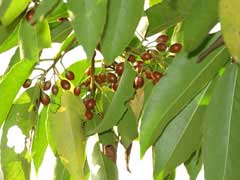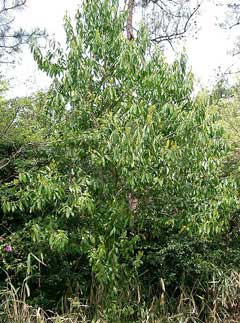 |
|
http://commons.wikimedia.org/wiki/User:KENPEI |
 |
| http://commons.wikimedia.org/wiki/User:KENPEI |
Translate this page:
Summary
Physical Characteristics

 Ilex purpurea is an evergreen Tree growing to 12 m (39ft 4in).
Ilex purpurea is an evergreen Tree growing to 12 m (39ft 4in).
See above for USDA hardiness. It is hardy to UK zone 8. It is in leaf all year, in flower from May to June, and the seeds ripen from September to December. The species is dioecious (individual flowers are either male or female, but only one sex is to be found on any one plant so both male and female plants must be grown if seed is required). and is pollinated by Bees. The plant is not self-fertile.
Suitable for: light (sandy), medium (loamy) and heavy (clay) soils. Suitable pH: mildly acid, neutral and basic (mildly alkaline) soils. It can grow in semi-shade (light woodland) or no shade. It prefers moist soil.
UK Hardiness Map
US Hardiness Map
Synonyms
I. chinensis. Sims.
Plant Habitats
Woodland Garden Canopy; Secondary;
Edible Uses
References More on Edible Uses
Medicinal Uses
Plants For A Future can not take any responsibility for any adverse effects from the use of plants. Always seek advice from a professional before using a plant medicinally.
Cancer Carminative Skin Tonic
This plant is commonly used in Chinese herbalism, where it is considered to be one of the 50 fundamental herbs[218]. It is reported to have antitumor properties[218]. An extract of the leaves is made into a solution and used for treating burns, ulcers in the lower extremities etc[218]. The ashes of the leaves are used as a dressing for skin ailments and poisoned wounds[218]. Seed is carminative and tonic[218].
References More on Medicinal Uses
The Bookshop: Edible Plant Books
Our Latest books on Perennial Plants For Food Forests and Permaculture Gardens in paperback or digital formats.

Edible Tropical Plants
Food Forest Plants for Hotter Conditions: 250+ Plants For Tropical Food Forests & Permaculture Gardens.
More

Edible Temperate Plants
Plants for Your Food Forest: 500 Plants for Temperate Food Forests & Permaculture Gardens.
More

More Books
PFAF have eight books available in paperback and digital formats. Browse the shop for more information.
Shop Now
Other Uses
References More on Other Uses
Cultivation details
Succeeds in most soils so long as they are not water-logged[200]. This species is not hardy in the colder areas of the country, it tolerates temperatures down to between -5 and -10°c[200]. According to another report, the plant is only hardy to about -3°c[260]. Resents root disturbance, especially as the plants get older[11]. It is best to place the plants into their permanent positions as soon as possible, perhaps giving some winter protection for their first year or two[K]. Plants are very tolerant of pruning and can be cut right back into old wood if required[188]. Dioecious. Male and female plants must be grown if seed is required.
References Carbon Farming Information and Carbon Sequestration Information
Temperature Converter
Type a value in the Celsius field to convert the value to Fahrenheit:
Fahrenheit:
The PFAF Bookshop
Plants For A Future have a number of books available in paperback and digital form. Book titles include Edible Plants, Edible Perennials, Edible Trees,Edible Shrubs, Woodland Gardening, and Temperate Food Forest Plants. Our new book is Food Forest Plants For Hotter Conditions (Tropical and Sub-Tropical).
Shop Now
Plant Propagation
Seed - best sown as soon as it is ripe in the autumn in a cold frame. It can take 18 months to germinate. Stored seed generally requires two winters and a summer before it will germinate and should be sown as soon as possible in a cold frame. Scarification, followed by a warm stratification and then a cold stratification may speed up the germination time[78, 80]. The seedlings are rather slow-growing. Pot them up into individual pots when they are large enough to handle and grow them on in light shade in a cold frame for their first year. It is possible to plant them out into a nursery bed in late spring of the following year, but they should not be left here for more than two years since they do not like being transplanted. Alternatively, grow them on in their pots for a second season and then plant them out into their permanent positions in late spring or early summer. Give them a good mulch and some protection for their first winter outdoors. Cuttings of almost ripe wood with a heel, August in a shaded position in a cold frame. Leave for 12 months before potting up. Layering in October. Takes 2 years[78].
Other Names
If available other names are mentioned here
Native Range
TEMPERATE ASIA: China (Yunnan Sheng), Japan TROPICAL ASIA: Vietnam
Weed Potential
Right plant wrong place. We are currently updating this section.
Please note that a plant may be invasive in one area but may not in your area so it's worth checking.
Conservation Status
IUCN Red List of Threatened Plants Status :

| Related Plants
|
| Latin Name | Common Name | Habit | Height | Hardiness | Growth | Soil | Shade | Moisture | Edible | Medicinal | Other |
| Ilex aculeolata | | Shrub | 3.0 |
-
| | LMH | SN | M | 1 | 0 | |
| Ilex aquifolium | Holly, English holl, Christmas Holly, Common Holly, English Holly | Shrub | 9.0 |
5-9
| S | LMH | FSN | DM | 2 | 2 | 4 |
| Ilex asprella | | Shrub | 3.0 |
-
| | LMH | SN | M | 0 | 2 | |
| Ilex cassine | Cassine, Dahoon, Cassine Holly | Tree | 10.0 |
7-11
| S | LMH | SN | M | 1 | 1 | 2 |
| Ilex chapaensis | | Shrub | 10.0 |
-
| | LMH | SN | M | 1 | 0 | |
| Ilex coriacea | Large Gallberry | Shrub | 3.0 |
6-9
| | LMH | SN | M | 1 | 0 | |
| Ilex cornuta | Horned Holly, Chinese holly | Shrub | 4.0 |
7-9
| M | LMH | SN | M | 1 | 2 | |
| Ilex crenata | Japanese Holly, Box Leaved Holly | Shrub | 5.0 |
6-8
| S | LMH | SN | M | 1 | 0 | 3 |
| Ilex glabra | Inkberry | Shrub | 3.0 |
3-7
| S | LMH | SN | M | 1 | 0 | 2 |
| Ilex integra | Mochi Tree | Tree | 6.0 |
6-9
| | LMH | SN | M | 1 | 0 | |
| Ilex latifolia | Tarajo | Tree | 10.0 |
6-9
| | LMH | SN | M | 1 | 0 | |
| Ilex macropoda | | Tree | 13.0 |
6-9
| | LMH | SN | M | 1 | 0 | |
| Ilex opaca | American Holly | Shrub | 15.0 |
4-8
| S | LMH | SN | M | 2 | 2 | 3 |
| Ilex pedunculosa | | Shrub | 10.0 |
4-8
| | LMH | SN | M | 1 | 1 | 3 |
| Ilex pubescens | | Shrub | 3.5 |
7-10
| | LMH | SN | M | 0 | 2 | |
| Ilex rotunda | Kurogane holly | Tree | 20.0 |
6-9
| | LMH | SN | M | 0 | 1 | |
| Ilex verticillata | Winterberry, Common winterberry | Shrub | 2.0 |
3-7
| S | LMH | SN | MWe | 1 | 3 | |
| Ilex vomitoria | Yaupon Holly, | Shrub | 6.0 |
6-9
| S | LMH | SN | M | 1 | 1 | 3 |
| Ilex x altaclerensis | Holly | Shrub | 4.0 |
5-9
| S | LMH | SN | M | 0 | 0 | 3 |
| Ilex yunnanensis | | Shrub | 4.0 |
5-9
| | LMH | SN | M | 0 | 1 | |
| Quercus ilex | Holly Oak, Evergreen Oak | Tree | 25.0 |
7-10
| S | LMH | SN | M | 5 | 2 | 3 |
| Quercus ilex ballota | Holm Oak | Tree | 25.0 |
6-9
| S | LMH | SN | M | 5 | 2 | 3 |
|
Growth: S = slow M = medium F = fast. Soil: L = light (sandy) M = medium H = heavy (clay). pH: A = acid N = neutral B = basic (alkaline). Shade: F = full shade S = semi-shade N = no shade. Moisture: D = dry M = Moist We = wet Wa = water.
Now available:
Food Forest Plants for Mediterranean Conditions
350+ Perennial Plants For Mediterranean and Drier Food Forests and Permaculture Gardens.
[Paperback and eBook]
This is the third in Plants For A Future's series of plant guides for food forests tailored to
specific climate zones. Following volumes on temperate and tropical ecosystems, this book focuses
on species suited to Mediterranean conditions—regions with hot, dry summers and cool, wet winters,
often facing the added challenge of climate change.
Read More
Expert comment
Author
Hassk.
Botanical References
200266
Links / References
For a list of references used on this page please go here
Readers comment
© 2010, Plants For A Future. Plants For A Future is a charitable company limited by guarantee, registered in England and Wales. Charity No. 1057719, Company No. 3204567.